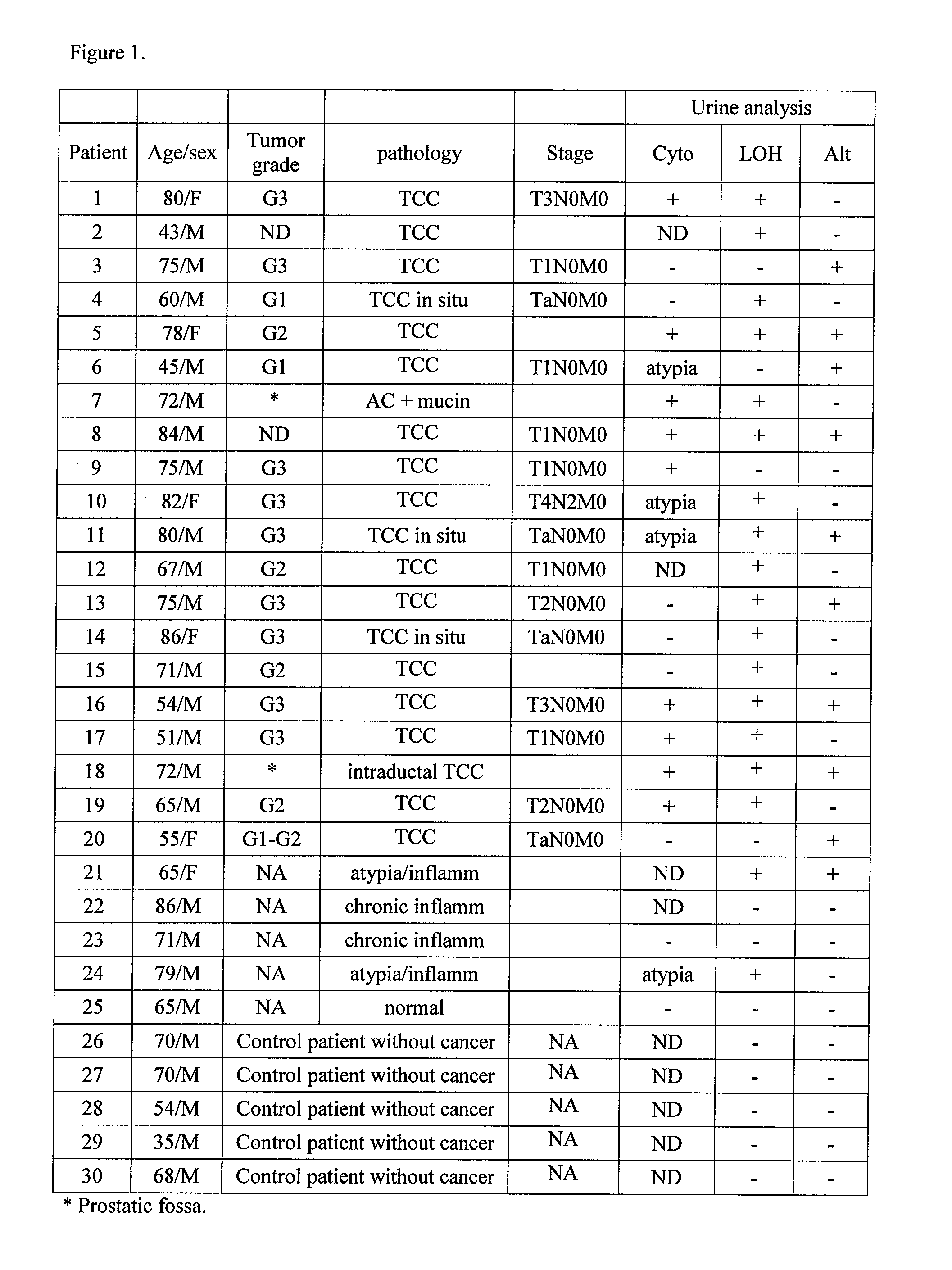Method for detecting cell proliferative disorders
a cell proliferative disorder and detection method technology, applied in the field of detection of target nucleic acid sequences, can solve the problems of difficult detection and treatment of bladder cancer, expensive and invasive procedures, and inability to detect and treat bladder cancer, etc., to achieve sensitive and non-invasive screening, fast and reliable results
- Summary
- Abstract
- Description
- Claims
- Application Information
AI Technical Summary
Benefits of technology
Problems solved by technology
Method used
Image
Examples
example 1
Molecular Detection of Primary Bladder Cancer by Microsatellite DNA Analysis
[0073]The purpose of this Example is to show that microsatellite DNA markers are useful as clonal markers for the detection of human cancer, because simple DNA repeat mutations can be readily detected in clinical samples by the polymerase chain reaction. In this Example, the feasibility of polymerase chain reaction-based microsatellite DNA analysis of DNA from urine sediment is shown by correctly identifying nineteen of twenty patients with primary bladder tumors by this approach. In contrast, using uDne cytology, only nme of eighteen affected patients were detected.
[0074]Sixty trinucleotide and tetrucleotide markers in the DNA from fifty anonymous primary bladder cancers were screened. The screening was done in the following manner: Frozen tumor tissue was cut into 10 mu.m sections. All samples, including lymphocytes, were digested with 1% SDS-proteinase K at 60.degree. C. for 5 hr. DNA was extracted by eth...
example 2
Microsatellite DNA Alterations in Serum DNA of Head and Neck Cancer Patients
[0086]The purpose of this Example is to show that microsatellite DNA analysis of serum represents a novel method for the detection of circulating tumor cell DNA. Lymphocyte, serum and tumor DNA were retrospectively analyzed from twenty-one head and neck cancer patients. Head and neck cancer remains a morbid and often fatal disease. Large tumor bulk and tumor extension are predictors of local regional recurrence and poor outcome. Molecular detection of occult neoplastic cells in surrounding surgical margins is a strong predictor of local regional recurrence resulting in a significant decrease in overall survival. In this Example, twenty-one patients were followed from initial diagnosis of transitional cell carcinoma with microsatellite DNA analysis of urine DNA at the time of cystoscopic evaluations scheduled at routine intervals. In almost all cases, DNA-based analysis correlated precisely with clinical find...
example 3
Detection of Bladder Cancer Reoccurrence by Microsatellite DNA Analysis of Urine
[0097]The purpose of this Example was to demonstrate that the microsatellite DNA analysis method can be used for following-up patients with transitional cell carcinoma. A reliable, non-invasive method for monitoring patients with transitional cell carcinoma of the bladder would be of great clinical benefit. In this Example, serial urine samples were tested from twenty-one patients who had been treated for bladder cancer with twenty polymorphic microsatellite DNA markers in a blinded fashion. Recurrent lesions were detected in ten out of eleven patients and correctly predicted the existence of a neoplastic cell population in the urine of two patients, four and six months before cystoscopic evidence of the tumor. The assay was negative in ten of ten patients who had no evident cancer. This Example shows that microsatellite DNA analysis of urine sediment represents a novel and potentially powerful clinical ...
PUM
| Property | Measurement | Unit |
|---|---|---|
| temperatures | aaaaa | aaaaa |
| temperatures | aaaaa | aaaaa |
| temperatures | aaaaa | aaaaa |
Abstract
Description
Claims
Application Information
 Login to View More
Login to View More - R&D
- Intellectual Property
- Life Sciences
- Materials
- Tech Scout
- Unparalleled Data Quality
- Higher Quality Content
- 60% Fewer Hallucinations
Browse by: Latest US Patents, China's latest patents, Technical Efficacy Thesaurus, Application Domain, Technology Topic, Popular Technical Reports.
© 2025 PatSnap. All rights reserved.Legal|Privacy policy|Modern Slavery Act Transparency Statement|Sitemap|About US| Contact US: help@patsnap.com



